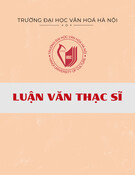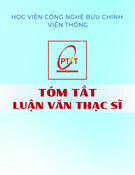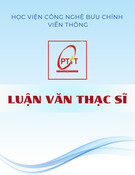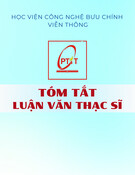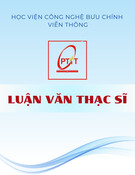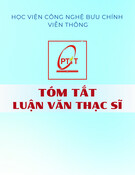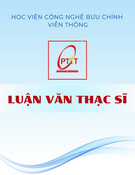
MINISTRY OF EDUCATION VIETNAM ACADEMY
AND TRAINING OF SCIENCE AND TECHNOLOGY
GRADUATE UNIVERSITY SCIENCE AND TECHNOLOGY
---------------
LE DUC THIEN
NEW PHYSICS EFFECT IN ADVANCED
ECONOMICAL 3-3-1 MODELS
SUMMARY OF PHYSICS DOCTORAL THESIS
HANOI- 2020

MINISTRY OF EDUCATION VIETNAM ACADEMY
AND TRAINING OF SCIENCE AND TECHNOLOGY
GRADUATE UNIVERSITY SCIENCE AND TECHNOLOGY
---------------
LE DUC THIEN
NEW PHYSICS EFFECT IN ADVANCED
ECONOMICAL 3-3-1 MODELS
SUMMARY OF PHYSICS DOCTORAL THESIS
Major: Theoretical and Mathematical Physics
Code: 62 44 01 03
Supervisor: Associate Prof. Phung Van Dong
Prof. Dang Van Soa
HANOI - 2020

INTRODUCTION
The motivation
The experimental puzzles in particle physics as well as cosmology, based on the standard
model and general relativity, cannot explain, including neutrino oscillation, matter-antimatter
asymmetry, dark matter, dark energy, and inflation.
In many extensions of the standard model, the 3-3-1 models promisingly is a potential
candidate for new physics. In particular, the model can address the number generation, the
quantization of electric, strong CP, flavor mixing, and the abnormal heaviness of top quark.
The 3-3-1 models are being investigated for solving these experimental issues.
In fact, one showed that the 3-3-1 models contain the seesaw mechanism and naturally
radiative corrections. They lead to the smallness neutrino mass and explain the lepton num-
ber asymmetry. Besides, they can supply dark matter candidates based on gauge principles
or inert scalar fields. The 3-3-1 model and other its versions also give the explanation to the
inflation issue and reheating in the universe through Higgs inflation scenario or a new scalar
field breaking the B−Lsymmetry.
The thesis proposes a class for the new economic 3-3-1 model, called a simple 3-3-1
model, in order to address the mentioned problems. The simple 3-3-1 model considers the
simplest lepton sector and the scalar sector. This setting leads to natural components of
the inert fields such as scalar inert fields and right-handed neutrino. The existing of these
fields brings the meaning for new physics anomalies, neutrino masses, and dark matter. In
addition, the flipped 3-3-1 model leads to natural candidates for dark matter unified with
normal particles in gauge multiples, and explain lepton flavor violation processes. Some new
physics predictions are also discussed.
Purpose and objective
•Investigate the simple 3-3-1 model with inert scalars: the model, interactions and its
consequences.
•Examine the flipped 3-3-1 model with the problems of neutrino masses, dark energy
1

and the flavor-changing neutral current..
Content
•The 3-3-1 model with inert scalar
- Investigate the model, introduce two inert scalar triplets to the model and finding
the conditions on the scalar potential parameters.
- Review the interaction.
- Review the physics of flavor and anomalous magnetic moment.
- Investigate the new physics effects at LHC.
- Define the bounds on the new physics scale from dijet and Drell-Yan processes.
•The flipped 3-3-1 model
- Propose the model
- Identify candidates for the dark matter
- Examine flavor-changing neutral currents
- Determine the lepton flavor violating processes
- Obtain the dark matter observables
- Investigate the new physics effects at LHC
Layout
Chapter 1: Introduction: We give a brief review of the Standard Model (SM) and the
experimental problems related to SM. The standard model’s extensions and the subject of
this thesis are discussed.
Chapter 2: Phenomenology of the simple 3-3-1 model with inert scalars: we introduce
two inert scalar triplets to the model, finding the condition for the scalar potential parameters
and all the interactions in the normal sector will be calculated. The inert field contains the
candidates for dark matter and its density, direct and indirect searching for the new particles
at LHC, as well as producing the dilepton, dijet, diboson at the LHC will be review.
Chapter 3: Dark matter and flavor changing in the flipped 3-3-1 model: We investigate
a minimal setup of this model and determine novel consequences of dark matter stability,
neutrino mass generation, and lepton flavor violation. We will discuss the dark matter ob-
servables and give rise to the LHC signals.
Conclusion: The general summary and conclusion of the work in the Ph.D thesis are
given.
2

CHAPTER 1. STANDARD MODEL AND ITS PROBLEMS
Modern physics are based on the standard model (SM) and the general relativistic
theory of gravity interactions. The standard model of electroweak and strong interaction,
has been experimentally tested with a very high precision. We are going to review the model
and discuss its serious problems on both of theoretical and experimental sides.
1.1. Standard model
The SM [1] is the model based upon the SU(3)C⊗SU(2)L⊗U(1)Y(3-2-1), where the
first group represents strong interaction of color charges (QCD), the last two term represent
the weak interaction between spin particles and (or) weak hypercharge.
Three generation of lepton and quark are arranged as (νaLeaL)∼(1,2,−1/2), eaR ∼
(1,1,−1), (uaLdaL)∼(3,2,1/6), uaR ∼(3,1,2/3), daR ∼(3,1,−1/3) transform belong to
the gauge group respectively and a= 1,2,3 are the generation number.
Gravity interaction are obtained by using general metric instead of Minkowski metric
and adding the Einstein-Hilbert action to the actions of SM. Gravity theory works at large
scale, describe the microscopic phenomenon up to less than 1 mm with great accuracy of less
than 10−3uncertainty [1].
1.2. Neutrino mass
In SM, neutrinos have exactly zero mass since right-handed neutrinos do not exist and
lepton number are always conserved in the model.
However, experiments which observed neutrinos from Earth’s atmosphere, from the sun,
from nuclear reactors or particle accelerators are proof the neutrino oscillations (changing
flavours) in the far enough distance, saying neutrino has to have nonzero mass (although
small below 1 eV) and mixed up.
1.3. Matter-antimatter asymmetry problem
The early Universe should have equal amounts of matter and antimatter, why today
everything we see from the smallest life forms on Earth to the largest stellar objects is made
3










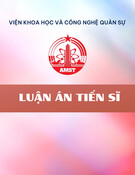



![Đề án Thạc sĩ: Tổ chức hoạt động văn hóa cho sinh viên Trường Cao đẳng Du lịch Hà Nội [Chuẩn nhất]](https://cdn.tailieu.vn/images/document/thumbnail/2025/20251202/kimphuong1001/135x160/91661764646353.jpg)


